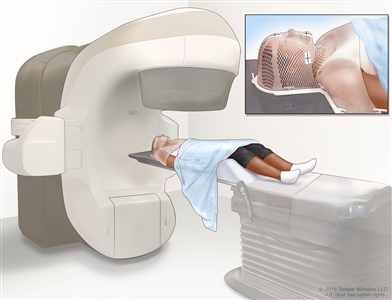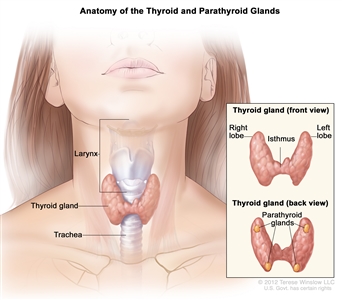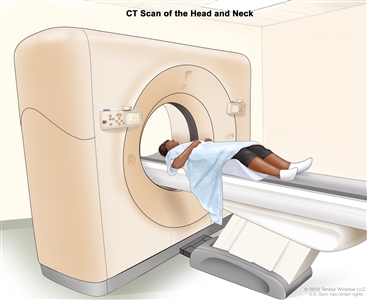Treatment Option Overview
There are different types of treatment for patients with parathyroid cancer.
Different types of treatment are available for patients with parathyroid cancer. Some treatments are standard (the currently used treatment), and some are being tested in clinical trials. A treatment clinical trial is a research study meant to help improve current treatments or obtain information on new treatments for patients with cancer. When clinical trials show that a new treatment is better than the standard treatment, the new treatment may become the standard treatment. Patients may want to think about taking part in a clinical trial. Some clinical trials are open only to patients who have not started treatment.
Treatment includes control of hypercalcemia (too much calcium in the blood) in patients who have an overactive parathyroid gland.
In order to reduce the amount of parathyroid hormone that is being made and control the level of calcium in the blood, as much of the tumor as possible is removed in surgery. For patients who cannot have surgery, medication may be used.
Four types of standard treatment are used:
Surgery
Surgery (removing the cancer in an operation) is the most common treatment for parathyroid cancer that is in the parathyroid glands or has spread to other parts of the body. Because parathyroid cancer grows very slowly, cancer that has spread to other parts of the body may be removed by surgery in order to cure the patient or control the effects of the disease for a long time. Before surgery, treatment is given to control hypercalcemia.
The following surgical procedures may be used:
- En bloc resection: Surgery to remove the entire parathyroid gland and the capsule around it. Sometimes lymph nodes, half of the thyroid gland on the same side of the body as the cancer, and muscles, tissues, and a nerve in the neck are also removed.
- Tumor debulking: A surgical procedure in which as much of the tumor as possible is removed. Some tumors cannot be completely removed.
- Metastasectomy: Surgery to remove any cancer that has spread to distant organs such as the lung.
Surgery for parathyroid cancer sometimes damages nerves of the vocal cords. There are treatments to help with speech problems caused by this nerve damage.
Radiation therapy
Radiation therapy is a cancer treatment that uses high-energy x-rays or other types of radiation to kill cancer cells or keep them from growing. There are two types of radiation therapy:
- External radiation therapy uses a machine outside the body to send radiation toward the area of the body with cancer.
- Internal radiation therapy uses a radioactive substance sealed in needles, seeds, wires, or catheters that are placed directly into or near the cancer.

External-beam radiation therapy of the head and neck. A machine is used to aim high-energy radiation at the cancer. The machine can rotate around the patient, delivering radiation from many different angles to provide highly conformal treatment. A mesh mask helps keep the patient's head and neck from moving during treatment. Small ink marks are put on the mask. The ink marks are used to line up the radiation machine in the same position before each treatment.
The way the radiation therapy is given depends on the type and stage of the cancer being treated. External radiation therapy is used to treat parathyroid cancer.
Chemotherapy
Chemotherapy is a cancer treatment that uses drugs to stop the growth of cancer cells, either by killing the cells or by stopping them from dividing. When chemotherapy is taken by mouth or injected into a vein or muscle, the drugs enter the bloodstream and can reach cancer cells throughout the body (systemic chemotherapy). When chemotherapy is placed directly into the cerebrospinal fluid, an organ, or a body cavity such as the abdomen, the drugs mainly affect cancer cells in those areas (regional chemotherapy). The way the chemotherapy is given depends on the type and stage of the cancer being treated.
Supportive care
Supportive care is given to lessen the problems caused by the disease or its treatment. Supportive care for hypercalcemia caused by parathyroid cancer may include the following:
- Intravenous (IV) fluids.
- Drugs that increase how much urine the body makes.
- Drugs that stop the body from absorbing calcium from the food we eat.
- Drugs that stop the parathyroid gland from making parathyroid hormone.
New types of treatment are being tested in clinical trials.
Information about clinical trials is available from the NCI website.
Treatment for parathyroid cancer may cause side effects.
For information about side effects caused by treatment for cancer, visit our Side Effects page.
Patients may want to think about taking part in a clinical trial.
For some patients, taking part in a clinical trial may be the best treatment choice. Clinical trials are part of the cancer research process. Clinical trials are done to find out if new cancer treatments are safe and effective or better than the standard treatment.
Many of today's standard treatments for cancer are based on earlier clinical trials. Patients who take part in a clinical trial may receive the standard treatment or be among the first to receive a new treatment.
Patients who take part in clinical trials also help improve the way cancer will be treated in the future. Even when clinical trials do not lead to effective new treatments, they often answer important questions and help move research forward.
Patients can enter clinical trials before, during, or after starting their cancer treatment.
Some clinical trials only include patients who have not yet received treatment. Other trials test treatments for patients whose cancer has not gotten better. There are also clinical trials that test new ways to stop cancer from recurring (coming back) or reduce the side effects of cancer treatment.
Clinical trials are taking place in many parts of the country. Information about clinical trials supported by NCI can be found on NCI's clinical trials search webpage. Clinical trials supported by other organizations can be found on the ClinicalTrials.gov website.
Follow-up tests may be needed.
As you go through treatment, you will have follow-up tests or check-ups. Some tests that were done to diagnose or stage the cancer may be repeated to see how well the treatment is working. Decisions about whether to continue, change, or stop treatment may be based on the results of these tests.
Some of the tests will continue to be done from time to time after treatment has ended. The results of these tests can show if your condition has changed or if the cancer has recurred (come back).
Parathyroid cancer often recurs. Patients should have regular check-ups for the rest of their lives, to find and treat recurrences early.


